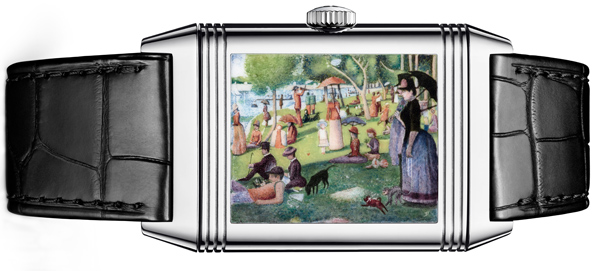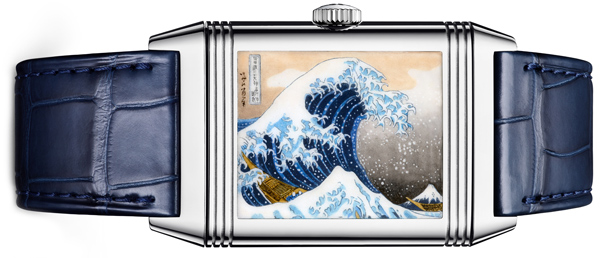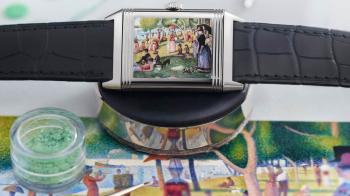To enhance the art of enamelling and engraving, so proudly mastered in the Vallée de Joux workshops, the Grande Maison had the idea of giving its Reverso pieces two faces revealing a work of art, the result of the artisans’ innovative work. On the front, a finely hand-guillochéd dial, covered in translucent Grand Feu enamel which is in harmony with the back of the watch. On the reverse, an enamelled miniature of a painting.
In 2018, following the pieces dedicated to Van Gogh or Magritte, Jaeger-LeCoultre chose three techniques representative of an iconic style: pointillism, ink wash painting, and Japanese woodblock printing. In order to represent these three techniques, never before applied to enamel in miniature at Jaeger-LeCoultre, three of their greatest masters were selected through one of their works: Georges Seurat, Xu Beihong and Katsushika Hokusai.
For these pieces of art, the Reverso Tribute Enamel, with its iconic Art Deco styling, was chosen. A case in white gold was created especially to host the enamel miniature.
Each of these models is issued in an eight-piece limited edition and available exclusively in Jaeger-LeCoultre Boutiques.
Reverso Tribute Enamel - Georges Seurat, A Sunday Afternoon on the Island of La Grande Jatte
The artisan guillocheur delicately decorated the reverse of the piece using a century-old machine which requires considerable expertise. The dial is guillochéd with small lozenges, which are embossed under a deep green translucent enamel. Hours of research were required in order for this colour to perfectly match the painting on the reverse.

Painted between 1884 and 1886, A Sunday Afternoon on the Island of La Grande Jatte is one of the most beautiful examples of the pointillist technique created by Georges Seurat (1859-1891). The technique of pointillism consists of juxtaposing minuscule dots of colour, rather than using larger brushstrokes, with the spectator’s eye naturally “mixing” the colours. It took Georges Seurat two years to complete this nearly 2 by 3 metre canvas. The painting is set on the banks of the Seine, near Paris, in a place where the locals would come to enjoy the water and a pleasant, unspoilt setting.
The artisan enameller had to take on a great number of challenges. The first was reproducing a more than 3-metre-wide painting onto a 3 cm2 surface. He also had to create his own pointillism technique and his own tools, including, for example, an extremely fine yet hard brush which frequently needed to be replaced. Pointillism on enamel is extremely complex. Several protective enamel layers must be superimposed upon one another after the completion of the painting, altering the intensity of the colour of the piece. A darker shade than the original was used in order to plan for this. In total, more than 70 hours were required to finish this creation, not counting the initial hours of research for the perfect colour.
Reverso Tribute Enamel– Inspired by a painting by Xu Beihong
The dial was delicately guillochéd in lengthwise geometric patterns and covered in opalescent ivory-coloured enamel, rendered as subtle as mother-of-pearl.
Xu Beihong (1895-1953) was one of the most renowned painters of the 20th century in China. He was known for his oil paintings, his drawings, his pastels and his calligraphy. His representations of horses made him very popular. The original, over 5-metre-wide painting shows ten horses galloping through a natural Chinese landscape. The enameller was inspired by the representation of two horses from the painting.

Again, there were several challenges in creating this miniature. The sense of movement, the fluidity and the lightness conveyed by the ink wash technique had to be reproduced despite the protective layers of the enamel, which reduce the image’s spontaneity. As such, the artisan spent many hours finding the right movement to best represent the horses’ energy. Additionally, it was a real challenge to portray the smallest details, such as the horses’ manes. Lastly, it should be noted that working practically in monochrome is another challenge for an artist such as an enameller, who is used to playing with colours.
Reverso Tribute Enamel – Katsushika Hokusai, The Great Wave off Kanagawa
On the front, the dial is delicately guillochéd with small waves, like an echo of the drawing found on the reverse. It is then covered with a translucent enamel, coloured with a blue as deep as the ocean represented by The Great Wave off Kanagawa.

Katsushika Hokusai (1760-1849) was a Japanese artist known for his woodblock print series, Thirty-six Views of Mount Fuji. It has remained iconic as it was the first time that the concept of perspective was integrated into the themes of the Japanese tradition of art. This series included The Great Wave off Kanagawa, which brought the artist fame not just in Japan, but in the rest of the world.
Once more, it was necessary to plan in order to achieve the desired colour as well as the tiniest elements which create the movement of the waves and the splashes of foam, without which the piece would lose all of its character and strength. It was also very difficult to reproduce such a calm and smooth sky, without a single brushstroke appearing. As such, this work presented the difficulties of the two preceding creations, demanding both an almost pointillist level of detail and the delicacy of Xu Beihong's expansive painting.






